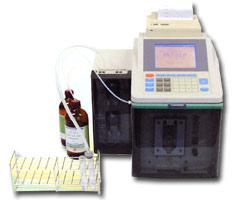|
Instrument Database:
Hitachi - Science & Technology - HG-310 Mercury analyzer
| |
|

|
| |
|
| |
|
| Year of introduction |
|
| Status |
available |
| Company |
Hitachi - Science & Technology
|
| Categories |
Dedicated Analyzer: Mercury
|
HG-310 is a mercury analyzer that addresses highly sensitive measurement with small amount of sample, reduction of reagent consumption and simplified maintenance by new design of the optical system and optimization of the measurement path.
A large LCD screen displays real-time absorbance curve, calibration plot and method parameters, which brings improved user interfaces.
A sophisticated software provides the function to handle various convenient files such as measurement condition files and result files, GLP function. RS-232C interface with optional data acquisition software allows edit and reevaluation of data on your PC. From wide range of system line up and accessories, you can select a most suitable model for your purpose, and future upgrades.
Features
- High sensitivity of lower detection down to 1 ppt Thanks to the newly designed optical system and improved measurement path, it delivers a high sensitivity of 1/500 of MCL (0.0005mg/L) the world.s most strict Japanese environmental guideline.
- Reduced sample and reagent consumption. Smaller sample and reagent consumption also reduces waste and consequently reduces the cost of your laboratory by a factor of four.
- GLP compliant function offers system maintenance information such as total time of mercury lamp in use, accumulated dispense volume from the dispenser, and alerting low reagent remain.
- Equipped with RS-232C interface, edit and reevaluation of data is possible on your PC (optional data acquisition software is required). In addition, data can be transferred to the HITACHI Polarized Zeeman Atomic Absorption spectrophotometer Z-5000 Series and it supports the management of AAS system.
|
| Specifications |
|
Measurement Method
Cold Vapor atomic absorption spectrometry
(Open-type aeration)
(Conformance to JIS K 0102 Plant, 66.1)
Sample volume for measurement
5 mL
Detection concentration range
0 to 100 ppb (0 to 500 ng/5 m L)
Detection limit
1 ppt (0.005 ng/5 mL)
Reproducibility
CV 3 % (in 1 ng/5 mL measurement, n = 6)
Reaction vessel
Special test tube
Desiccation method
Electronic cooling method
Mercury collection method
Collection by activated charcoal
Absorption cell
Quartz absorption cell
Light source
Low pressure mercury lamp
Detector
Photoelectric cell
Measurement mode
(1) Peak Height mode (2) Integration mode
Calibration function
Multi point calibration curves (Up to 6 points) Up to 6 calibration curves can be stored.
Number of measurement
Approximately 50 specimens (when measurement period for 1 specimen is 6 minutes)
Calculation function (1) Concentration calculation
(ng, ppt, ppb, ppm, g/L)
(2) Statistical calculation
(average value, standard deviation, coefficient of variation)
(3) Re-calculation
(re-calculation by changes in sample volume, unit, and/or collection rate)
Sample file
Measurement condition file for each sample, 99 files
Condition file
Measurement condition files, 6 files
Analog output
DC 0 to 1 V (variable span setting)
External output
RS-232C data output
GLP supporting functions
(1) Total period of lamp use
(2) Total period of air supply pump
(3) Total period of activated charcoaluse
(4) Accumulated dispense volume from dispenser (optional) and warning for remaining reagent
Dimensions
Weight Main unit (without optional dispenser and printer):
250W x 360D x 380H (mm) Approx. 12 kg
Options
Foaming detection unit
Contamination of measurement cell by foaming of sample can be prevented. The system can be set to stop measurement by foam detection.
|
|